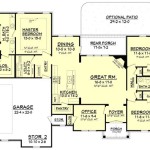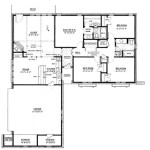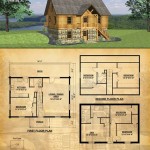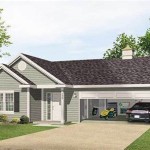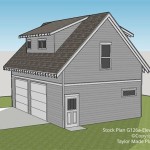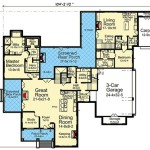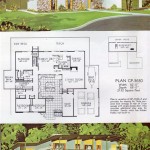One-Story House Designs and Floor Plans: A Comprehensive Overview
One-story house designs, also known as ranch-style or single-level homes, offer a compelling alternative to multi-story dwellings, particularly for individuals and families seeking accessibility, convenience, and potentially lower long-term maintenance costs. These homes are characterized by horizontal layouts, typically featuring all living spaces, bedrooms, and bathrooms on a single floor. This design approach presents unique advantages and challenges that necessitate careful consideration during the planning and construction phases.
The popularity of one-story house designs stems from their inherent simplicity and adaptability. They can be customized to suit a wide range of lifestyles and preferences, accommodating everything from compact, minimalist residences to sprawling estates with expansive open floor plans. The absence of stairs makes them particularly attractive to families with young children, individuals with mobility limitations, and those planning to age in place. Furthermore, single-story construction can often be more cost-effective than multi-story construction, although this is highly dependent on lot size, design complexity, and material choices.
Accessibility and Universal Design Principles
One of the most significant benefits of one-story house designs is their inherent accessibility. The absence of stairs eliminates a major barrier for individuals with mobility challenges, making the home more user-friendly and accommodating for people of all ages and abilities. This aligns directly with the principles of universal design, which aims to create environments that are accessible and usable by everyone, regardless of their physical or cognitive abilities.
Beyond the absence of stairs, one-story floor plans can be further enhanced to incorporate a variety of accessibility features. Wider doorways and hallways can facilitate wheelchair maneuverability. Roll-in showers and grab bars in bathrooms can promote safety and independence. Lowered countertops and appliances in the kitchen can make the space more accessible for individuals with limited reach. These modifications can significantly improve the quality of life for residents and ensure that the home remains adaptable to their evolving needs.
Incorporating universal design principles from the outset of the design process is often more cost-effective than retrofitting a home later on. Careful planning and consideration of future needs can result in a home that is not only accessible but also aesthetically pleasing and functional for all occupants.
Floor Plan Considerations for One-Story Homes
Designing an effective floor plan for a one-story house requires careful attention to space allocation, flow, and functionality. Because all living spaces are located on a single level, it is crucial to optimize the layout to maximize efficiency and minimize wasted space. The floor plan should also consider the orientation of the house on the lot to take advantage of natural light and ventilation.
Open floor plans are a popular choice for one-story homes, as they promote a sense of spaciousness and create a seamless connection between living areas. Combining the kitchen, dining room, and living room into a single open space can enhance social interaction and make the home feel more inviting. However, it is important to carefully delineate these spaces through the use of furniture, flooring, and architectural details to maintain a sense of order and visual appeal.
Another important consideration is the placement of bedrooms and bathrooms. Ideally, bedrooms should be located away from high-traffic areas to provide privacy and quiet. Master suites often include a private bathroom and walk-in closet, creating a luxurious and functional retreat. The number of bedrooms and bathrooms should be tailored to the needs of the occupants and the overall size of the house.
Furthermore, adequate storage space is essential in a one-story home. Closets, pantries, and built-in storage units can help to keep the home organized and clutter-free. Consider incorporating storage solutions throughout the house, including in hallways, bedrooms, and bathrooms.
Advantages and Disadvantages of Single-Story Living
Choosing a one-story house design involves weighing its advantages and disadvantages against individual needs and priorities. The benefits, as mentioned previously, include enhanced accessibility, simplified maintenance, and potentially lower construction costs. However, there are also potential drawbacks to consider, such as increased land usage, privacy concerns, and limitations on expansion.
Because one-story houses require a larger footprint than multi-story homes, they typically require a larger lot. This can be a significant factor in areas where land is scarce or expensive. The increased land usage can also translate to higher property taxes and landscaping costs.
Privacy can also be a concern in one-story homes, particularly if the house is located close to neighboring properties. Large windows and sliding glass doors, while desirable for natural light and views, can also compromise privacy. Careful landscaping, window treatments, and strategic placement of rooms can help to mitigate this issue.
Finally, expanding a one-story house can be more challenging than adding onto a multi-story home. Adding a second story may be structurally feasible, but it can be a significant undertaking. Extending the footprint of the house is often the only option, which may be limited by lot size and zoning restrictions.
Ultimately, the decision of whether to build or buy a one-story house depends on a variety of factors, including budget, lifestyle, and personal preferences. By carefully considering the advantages and disadvantages, and by working with a qualified architect or builder, it is possible to create a one-story home that is both functional and beautiful.
In addition to the core structural design, energy efficiency should also be a primary focus. Single-story homes, by virtue of their design, can be susceptible to heat loss through the roof. Therefore, proper insulation is critical. Utilizing energy-efficient windows, doors, and HVAC systems can further reduce energy consumption and lower utility bills. Solar panels can also be integrated into the roof design to generate renewable energy and reduce reliance on the grid.
Outdoor living spaces are also an important consideration. Patios, decks, and porches can extend the living area of a one-story home and provide opportunities for outdoor relaxation and entertainment. These spaces can be designed to seamlessly integrate with the interior of the house, creating a cohesive and inviting living environment. Landscaping can also play a crucial role in enhancing the curb appeal of a one-story home and creating a sense of privacy and tranquility.
The materials used in the construction of a one-story house can also have a significant impact on its cost, durability, and aesthetic appeal. Choosing sustainable and locally sourced materials can help to reduce the environmental impact of the construction process and create a healthier living environment. Consider using durable and low-maintenance materials, such as brick, stone, or fiber cement siding, to minimize long-term maintenance costs.
In conclusion, one-story house designs offer a range of advantages and disadvantages that should be carefully considered when planning a new home. By focusing on accessibility, functionality, and energy efficiency, it is possible to create a one-story house that is both comfortable and sustainable. Working with experienced professionals, such as architects and builders, is essential to ensure that the design meets the specific needs and preferences of the occupants.

Small House Design Shd 2024007 Pinoy Eplans One Y Bungalow Plans Layout

Wonderful One Y House Designs With Three Bedrooms Ulric Home Projects Architecture Model Plan

Wonderful One Y House Designs With Three Bedrooms Ulric Home Model Plan Bungalow Style Plans

Unique One Story House Plans Monster

Stylish One Story House Plans Blog Eplans Com

Stylish One Story House Plans Blog Eplans Com

Single Story House Floor Plans Bedroom Y

Unique One Story House Plans Monster
House Plan Of The Week Simple One Story Design Builder

Must Have One Story Open Floor Plans Blog Eplans Com

